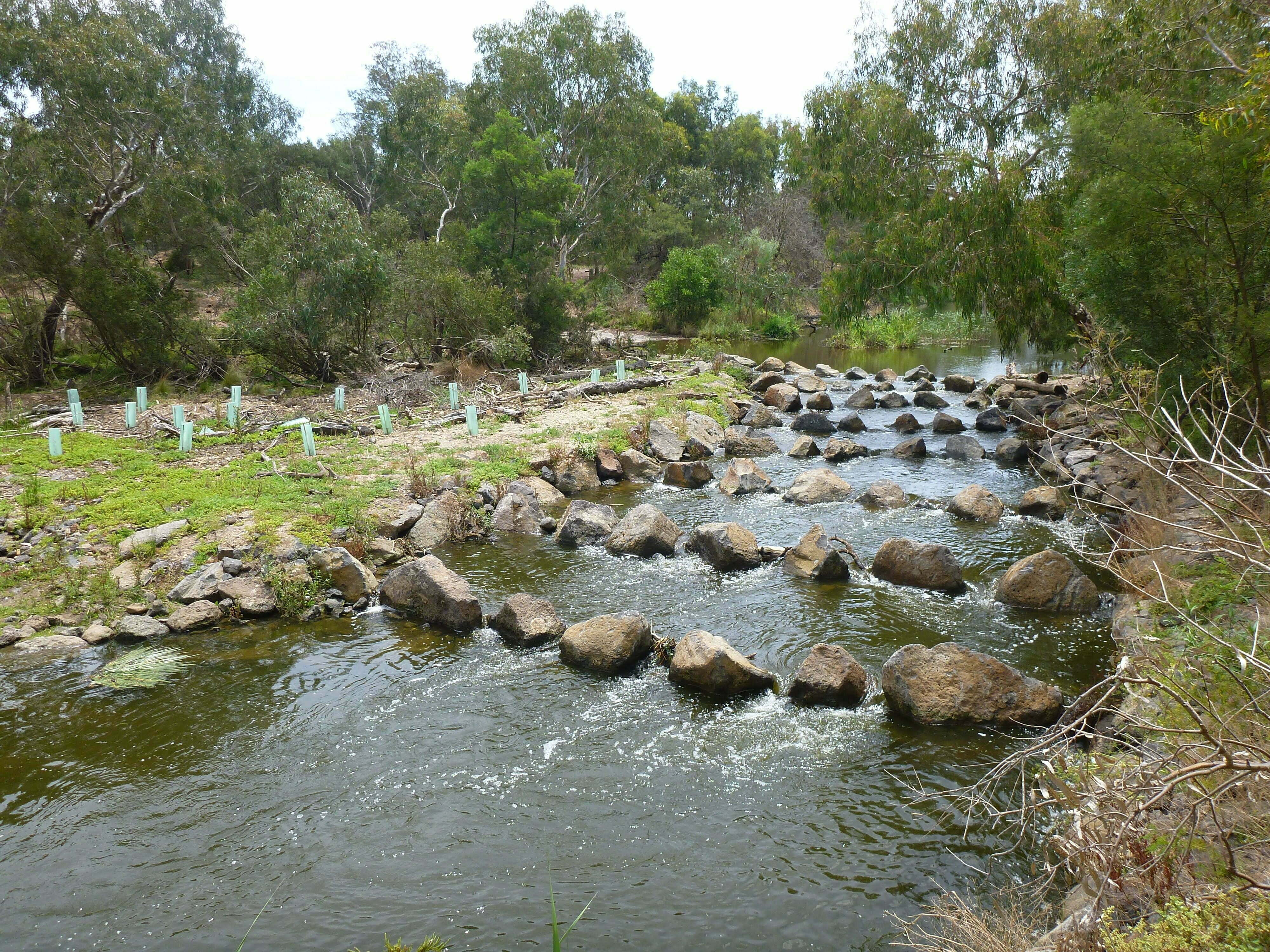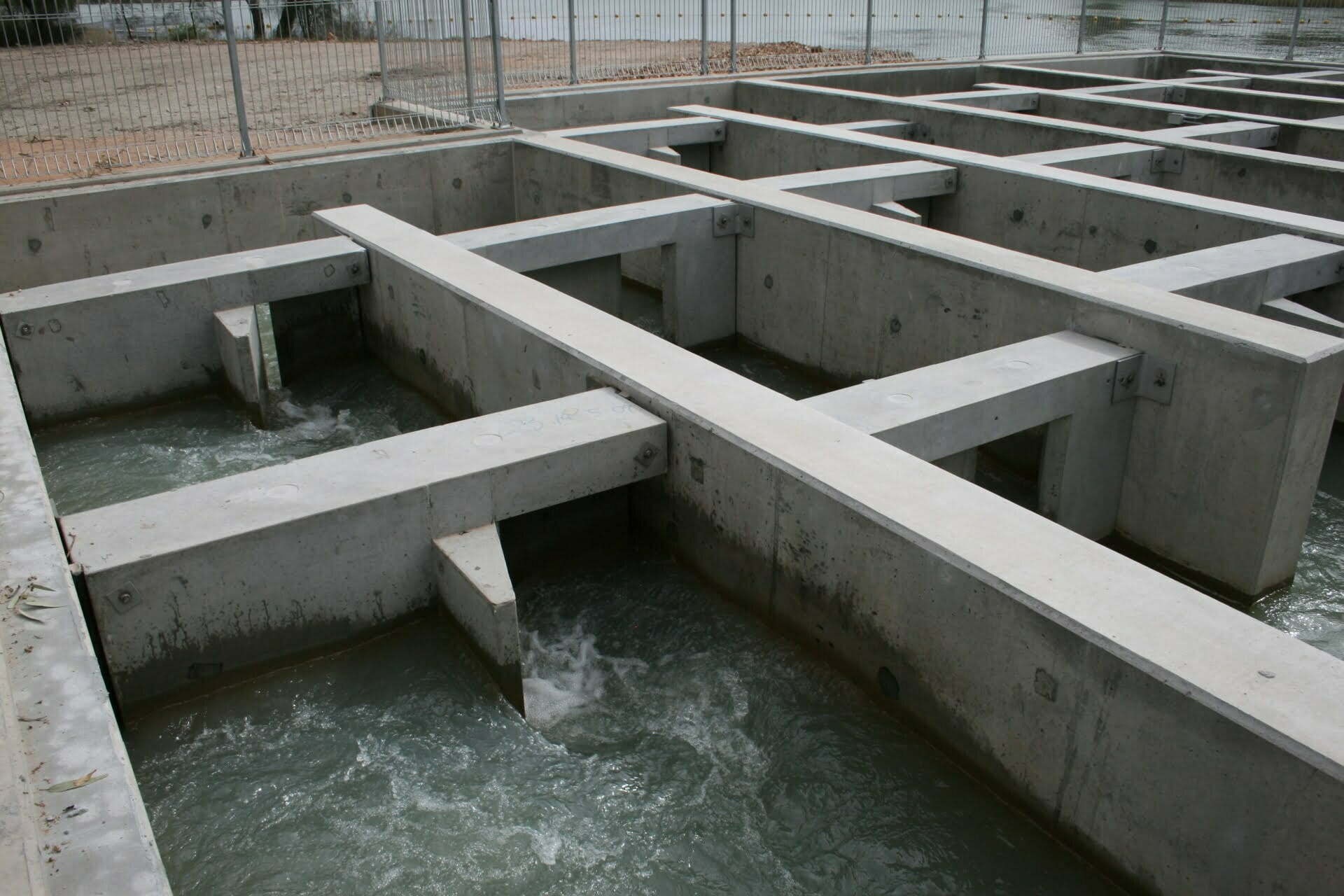
Quick tips:
- The first priority is to identify the movement requirements of the fish community in the demonstration reach.
- The reach can then be surveyed to determine potential barriers and their likely impacts on fish passage. Engineering and fish biology expertise is required early on in the process and through to the construction and commissioning stage.
- When sites have been prioritised, conceptual designs can be drawn up and likely costs estimated. These can be used to seek funding.
- If funds are available, detailed designs can be drawn up followed by construction and commissioning of the fishway.
- It is important to negotiate operational and maintenance requirements with appropriate jurisdictional and local government agencies. Well-designed fishways do not operate without specific flow allocations, and ongoing maintenance will be required.
Native fishes move within and between habitats. Movements may be meso-scale (short-term movements within the normal home range), or macro-scale (prolonged long-term, large scale movements between habitats. They may be longitudinal (up and downstream) or lateral (channel to the floodplain for example). Movements have been documented in both large bodied fish (e.g. Murray cod, Golden perch) and small-bodied species (e.g. Gudgeons and Spangled perch), and in all life history stages of species.
Barriers to fish movements include physical barriers ranging from large dams, weirs, culverts and road crossings, as well as shallow areas of river caused by reduced flows. Barriers can also include low water temperatures (cold water pollution) and changes in flow regimes that result in a lack of flow cues for migratory species such as Golden perch.


Identifying problem sites:
The first step in to identify potential problem sites, these can be identified by going through the following process:
What fish species are present and what are their movement requirements?
Data will be available on fish species present in the demonstration reach, and there is now sufficient information available in the literature to indicate the movement requirements of most species, including the seasonality of that movement. The presence of any threatened species will increase the need for action.
Identify potential barriers
The next step is to identify potential barriers. Dams and weirs are obvious ones, but other structures like small culverts and road crossings can potentially form barriers to fish movement and should be investigated.
Frequency of present fish passage
How much fish passage do the current structures allow? What is the drown out frequency of weirs etc? What velocities are experienced through culverts etc? Expert advice from hydrologists and fish biologists is useful in deciding possible actions.
Habitat area impacted
What habitat would be opened up to fish, and what quality is that habitat? In a demonstration reach where habitat rehabilitation is being undertaken, consideration should be given not just to current habitat condition, but to the expected condition of the habitat in the future.
Other factors
Are there factors that cannot easily be controlled within the demonstration reach? For example, is there a cold water pollution issue that cannot be addressed, or are there flow regime issues etc?
If the above process reveals significant fish passage issues that can be addressed, the next step is to investigate solutions at each site, and the costs of rehabilitation actions.
Determining potential solutions and their costs:
Once sites for rehabilitation are prioritised, the next step is to develop conceptual designs for these sites. Both engineering and fish biology expertise relating to the design and costs of fishways are essential. Fortunately, over the last 20 years a significant amount of expertise has been built up in designing fishways for Australian conditions and for native fishes. This expertise is available in a number of jurisdictional natural resource management agencies and through consultants.
This conceptual design stage will enable a realistic cost estimate to be made. The type of fishway may vary from rock ramp structures, baffles in culverts to vertical slot fishways or fish locks on high structures and costs will vary accordingly. Fish passage improvements can also be undertaken when road crossings etc. are being upgraded by ensuring that fish friendly river crossings are installed (see Why do fish need to cross the-road? booklet)
Funding:
Funding for fishways is highly variable and can seem prohibitive where highly engineered structures such as vertical slot fishways are required. It is worth investigating Commonwealth, State and regional funding opportunities, as fish passage is widely recognised as vital for species survival. A concept design, together with the logic for selecting the particular site and the likely benefits, can add credibility to an application. The Whole of Life Plan indicating other complementary habitat rehabilitation actions will also support the application.
Construction:
If funding is obtained, detailed design will then be undertaken followed by construction and commissioning of the fishway. It is important that negotiations are undertaken with both jurisdictional and local government agencies to ensure that the operational requirements of the fishway are agreed to (including watering requirements), and that a maintenance schedule is agreed to, including removal of debris after flooding etc.)

Example 4i
Loudoun Weir Fishway – Dewfish Reach – Condamine Alliance.
Loudoun Weir on the Condamine River supplies water to the town of Dalby. Originally about 4m in height it was constructed in 1959 and fitted with an ineffective pool and weir fishway. In 1995 the weir height was increased by 1.2m and a new fishway was required under state fisheries legislation. A vertical slot fishway was subsequently built but unfortunately had some design faults.
With the implementation of the Dewfish Demonstration Reach Project, the Condamine Alliance gave priority to increasing the effectiveness of the fishway. It has subsequently been upgraded in 2006 and 2012 and these upgrades together with ongoing maintenance activities have seen significant increases in native fish numbers upstream of the weir. Key points are:
- The Condamine Alliance has had to work over a long period of time with multiple stakeholders to achieve a successful result including; local, state and Commonwealth government agencies, private contractors and local communities. There has not always been agreement and the persistence of key people has been vital.
- As well as design and construction, operation and maintenance are key.
- Negotiations to achieve appropriate operating plans for the fishway have been difficult and protracted but worked through with operators. Full credit must be given to the WDRC staff that operates the fishway according to the plan. Education of the staff and management was critical to achieving this outcome
- There is a need for ongoing maintenance particularly on a river like the Condamine where flood levels can result in high sediment and wood debris loads affecting the operation of the fishway.
New South Wales Department of Primary Industries – Barriers to Fish Passage
Queensland Department of Agriculture and Fisheries – Instream structures and barriers
Victoria Arthur Rylah Institute – Guidelines for fish passage at small structures
Victoria Arthur Rylah Institute – Fishways and Fish Movement
Murray Darling Basin Authority – Sea to Hume Dam Project (fish passage)